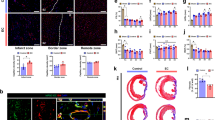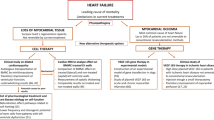Abstract
Cell therapy is a promising option for the treatment of ischemic diseases. Infusion or injection of stem or progenitor cells has improved neovascularization and heart function after ischemia in various experimental studies and clinical phase II and III trials. One potential limitation for cell therapy is a low rate of engraftment and persistence of cells in the ischemic tissue. Moreover, impairment of the number and function of patient-derived progenitor cells might limit the efficiency of autologous stem cell therapy. Therefore, strategies to augment cell function, survival, and homing could be crucial to improve success rates for cell therapy. Experimental studies have provided novel options for improving survival and function by transduction of stem or progenitor cells with prosurvival genes (e.g. Akt or telomerase). Pretreatment of cells with small molecules, such as statins, p38 inhibitors, or endothelial nitric oxide synthase enhancers, has been used to augment cell homing, integration, and functional recovery after induction of ischemia. Priming of the tissue by mechanical activation or application of growth factors might further improve recruitment and incorporation of cells. In this article we summarize the experimental studies providing novel concepts for cell-enhancement strategies to aid the treatment of peripheral artery occlusive and ischemic heart disease.
Key Points
-
Cell therapy is a promising option in the treatment of ischemic diseases
-
Circulating and bone marrow-derived progenitor cells from patients with coronary artery disease are impaired in function
-
Augmentation of the functional activity of patient-derived cells may improve the efficiency of autologous cell therapy
-
Strategies to augment homing, survival, and incorporation of infused or injected progenitor cells may increase the functional benefit of cell therapy
This is a preview of subscription content, access via your institution
Access options
Subscribe to this journal
Receive 12 print issues and online access
$209.00 per year
only $17.42 per issue
Buy this article
- Purchase on Springer Link
- Instant access to full article PDF
Prices may be subject to local taxes which are calculated during checkout

Similar content being viewed by others
References
Dimmeler S et al. (2005) Unchain my heart: the scientific foundations of cardiac repair. J Clin Invest 115: 572–583
Vasa M et al. (2001) Number and migratory activity of circulating endothelial progenitor cells inversely correlate with risk factors for coronary artery disease. Circ Res 89: E1–7
Tepper OM et al. (2002) Human endothelial progenitor cells from type II diabetics exhibit impaired proliferation, adhesion, and incorporation into vascular structures. Circulation 106: 2781–2786
Valgimigli M et al. (2004) CD34+ and endothelial progenitor cells in patients with various degrees of congestive heart failure. Circulation 110: 1209–1212
Heeschen C et al. (2004) Profoundly reduced neovascularization capacity of bone marrow mononuclear cells derived from patients with chronic ischemic heart disease. Circulation 109: 1615–1622
Murasawa S et al. (2002) Constitutive human telomerase reverse transcriptase expression enhances regenerative properties of endothelial progenitor cells. Circulation 106: 1133–1139
Mangi AA et al. (2003) Mesenchymal stem cells modified with Akt prevent remodeling and restore performance of infarcted hearts. Nat Med 9: 1195–1201
Choi JH et al. (2004) Augmentation of therapeutic angiogenesis using genetically modified human endothelial progenitor cells with altered glycogen synthase kinase-3[beta] activity. J Biol Chem 279: 49430–49438
Cho HJ et al. (2005) Regulation of endothelial cell and endothelial progenitor cell survival and vasculogenesis by integrin-linked kinase. Arterioscler Thromb Vasc Biol 25: 1154–1160
Gnecchi M et al. (2005) Paracrine action accounts for marked protection of ischemic heart by Akt-modified mesenchymal stem cells. Nat Med 11: 367–368
Iwaguro H et al. (2002) Endothelial progenitor cell vascular endothelial growth factor gene transfer for vascular regeneration. Circulation 105: 732–738
Kong D et al. (2004) Enhanced inhibition of neointimal hyperplasia by genetically engineered endothelial progenitor cells. Circulation 109: 1769–1775
Dimmeler S et al. (2001) HMG-CoA reductase inhibitors (statins) increase endothelial progenitor cells via the PI 3-kinase/Akt pathway. J Clin Invest 108: 391–397
Walter DH et al. (2002) Statin therapy accelerates reendothelialization: a novel effect involving mobilization and incorporation of bone marrow-derived endothelial progenitor cells. Circulation 105: 3017–3024
Sasaki K et al. (2006) Ex vivo pretreatment of bone marrow mononuclear cells with endothelial NO synthase enhancer AVE9488 enhances their functional activity for cell therapy. Proc Natl Acad Sci USA 103: 14537–14541
Verma S et al. (2004) C-reactive protein attenuates endothelial progenitor cell survival, differentiation, and function: further evidence of a mechanistic link between C-reactive protein and cardiovascular disease. Circulation 109: 2058–2067
Seeger FH et al. (2005) p38 mitogen-activated protein kinase downregulates endothelial progenitor cells. Circulation 111: 1184–1191
Hofmann M et al. (2005) Monitoring of bone marrow cell homing into the infarcted human myocardium. Circulation 111: 2198–2202
Ceradini DJ et al. (2004) Progenitor cell trafficking is regulated by hypoxic gradients through HIF-1 induction of SDF-1. Nat Med 10: 858–864
Grunewald M et al. (2006) VEGF-induced adult neovascularization: recruitment, retention, and role of accessory cells. Cell 124: 175–189
Yamaguchi J et al. (2003) Stromal cell-derived factor-1 effects on ex vivo expanded endothelial progenitor cell recruitment for ischemic neovascularization. Circulation 107: 1322–1328
Davis ME et al. (2006) Local myocardial insulin-like growth factor 1 (IGF-1) delivery with biotinylated peptide nanofibers improves cell therapy for myocardial infarction. Proc Natl Acad Sci USA 103: 8155–8160
Limana F et al. (2005) Exogenous high-mobility group box 1 protein induces myocardial regeneration after infarction via enhanced cardiac C-kit+ cell proliferation and differentiation. Circ Res 97: e73–83
Author information
Authors and Affiliations
Corresponding author
Ethics declarations
Competing interests
S Dimmeler and AM Zeiher are named as co-inventors on a patent application (“Use of eNOS transcription enhancers in the cell therapy of ischemic heart diseases”) filed by Aventis Pharmaceuticals Inc. (US application #20050101599) and on a patent application (“Shock wave pretreatment as a therapeutic tool for targeted recruitment of stem/progenitor cells”) filed by Dornier MedTech Systems GmbH.
F H Seeger declared no competing interests.
Rights and permissions
About this article
Cite this article
Seeger, F., Zeiher, A. & Dimmeler, S. Cell-enhancement strategies for the treatment of ischemic heart disease. Nat Rev Cardiol 4 (Suppl 1), S110–S113 (2007). https://doi.org/10.1038/ncpcardio0734
Received:
Accepted:
Issue Date:
DOI: https://doi.org/10.1038/ncpcardio0734
This article is cited by
-
SDF-1/CXCR4 axis induces human dental pulp stem cell migration through FAK/PI3K/Akt and GSK3β/β-catenin pathways
Scientific Reports (2017)
-
The Challenges of Autologous Cell Therapy: Systemic Anti-thrombotic Therapies Interfering with Serum Coagulation May Disable Autologous Serum-Containing Cell Products for Therapeutical Use
Journal of Cardiovascular Translational Research (2014)
-
Diabetes-associated macrovascular complications: cell-based therapy a new tool?
Endocrine (2013)
-
SPECT and PET to optimize cardiac stem cell therapy
Journal of Nuclear Cardiology (2012)
-
Emerging roles for integrated imaging modalities in cardiovascular cell-based therapeutics: a clinical perspective
European Journal of Nuclear Medicine and Molecular Imaging (2012)



